Komondor
The Komondor, plural Komondorok, is one of the most recognizable breeds with its shaggy, long, white coat and sweet disposition. It is a loving, protective, attentive dog that is an excellent companion.
It gets its name from the Cuman people, a nomadic tribe who brought this breed into Hungary. “Cuman-dor” means “dog of the Cumans,” hence Komondor. Its large, robust body, heavy corded hair, curled tail, and strong legs show its heritage as a sheep-guarding dog. This large dog may look bulky, but is incredibly agile. Despite its rough appearance, this is a noble, loyal, and alert dog.
Komondor Pictures
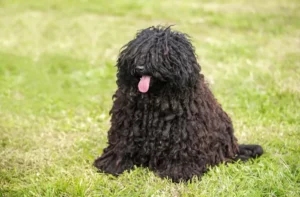
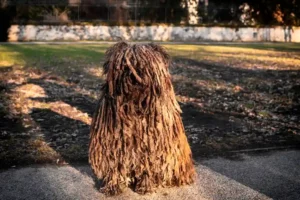
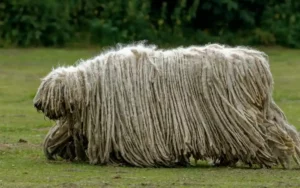
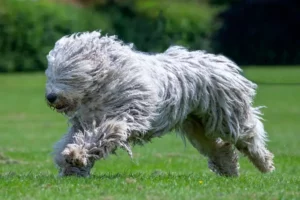
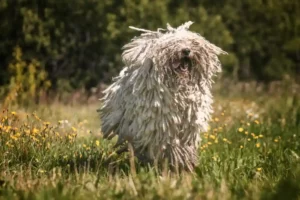
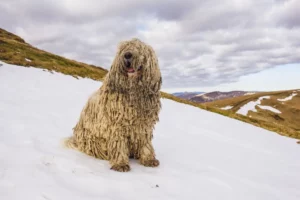
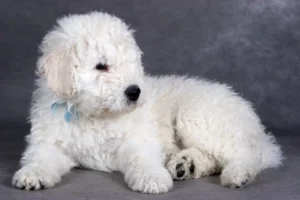
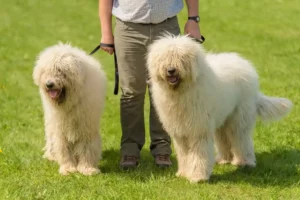
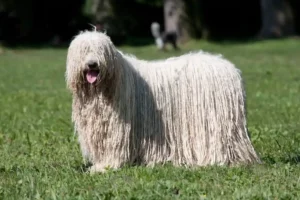
Quick Information
| Other names | Hungarian Sheepdog, Hungarian Commonmop, Mop Dog |
| Coat | Long, corded double coat with a soft undercoat and a coarse outer coat |
| Color | White |
| Breed type | Purebred |
| Group | Working |
| Life expectancy | 10-12 years |
| Size | Large |
| Height | Male – 27.5 – 31.5 inchesFemale – 25.5 – 27.5 inches |
| Weight | Male – 110- 132 poundsFemale – 88 – 110 pounds |
| Litter Size | 6-12 puppies |
| Behavioral Characteristics | Affectionate, loving, independent, calm, and steadfast |
| Good with children | Moderate; may hurt smaller children with their size |
| Barking Tendency | Moderate; they have deep, booming bark |
| Climate compatibility | Low; they need colder climates due to their thick coats |
| Apartment compatibility | Low; they require large open spaces |
| Do they shed | Very little; they shed seasonally |
| Are they hypoallergenic | No |
| Trainability | Moderate; they are very independent and might not listen at first |
| How much do they cost | $800 – $1,500 |
| Competitive Registration Qualification/Information | AKC, UKC, FCI |
| Country | Hungary |
History and Origin
One of three native working dogs, the Komondor was brought to modern-day Hungary by the nomadic Cumans, a Turkic-speaking tribe who migrated to the region in the 12th and 13th centuries. This breed was first mentioned in the 16th century. It likely descended from Tibetan and Russian dogs like the Aftscharka, which accompanied their masters on their voyage across Asia into Europe. Herders traditionally used it to guard sheep as its corded coat allowed it to mix with the flock and fool predators. Also, its thick coat protected it from predator’s teeth.
The first Komondor entered the US in 1933, and the AKC officially recognized it in 1937. During WWII, it nearly became extinct, but it was saved by the efforts of activists, making it gain prominence outside Hungary in the 1960s. It manages flocks even today, and graces show rings with majestic appearances.
Temperament and Personality
The Komondor is an intelligent, calm, and fearless dog. It is incredibly loyal and will protect its owner with all its strength in the face of danger. This quality makes it a great family dog that does well with children. However, you must be careful around younger children as they may get hurt due to their size. It is shy around strangers but affectionate with family and other pets. Still, be careful around unfamiliar animals as they may trigger the Komondor’s guarding instincts. Its alert and vigilant nature make it an excellent guard dog and watchdog; however, it enjoys resting and loves to nap at its owner’s feet.
The Komondor is a high-maintenance breed. It needs large open spaces to run around and has a deep, booming bark, making it ill-suited for city life. Its heavy, corded coat requires extensive care and grooming. Independent and wilful, it may be challenging to handle for novices. However, with proper training and socialization, a Komondor is one of the most loving and steadfast pets one can have.
Care
Exercise
Despite their size and strength, Komondorak only need moderate exercise to stay healthy. Two to three short daily walks, along with running and playtime in a large fenced enclosure or yard, are sufficient. Group play is good for mental and physical stimulation if you have other pets. Avoid dog parks, as the unfamiliar environment can make them territorial and aggressive. You should also avoid swimming as their coat might become wet and unmanageable.
Grooming
The Komondor’s distinctive corded coat results from manual care and upkeep. Young Komondorak have a short coat that curls as they grow up. At around 9-10 months, the coat starts to clump together, at which point human intervention is needed to separate the clumps into proper dreads. As a result, they shed very little and don’t require brushing. Their coat should not smell bad, so ensure you give them regular baths with mild shampoo. Rinse out all the shampoo and towel dry before letting the coat dry under a strong fan or blower. This process usually takes a whole day but is essential for maintaining hygiene and avoiding a shaggy, unkempt look.
While bathing, you must check for skin infections and mold. Also, brush your dog’s teeth twice or thrice weekly to avoid dental issues, and clip the nails when they get too long.
Health Problems
The Komondor is a very healthy breed. However, it may suffer some conditions typical for dogs of its size, such as GDV or bloat, hip dysplasia, and entropion. Regular health check-ups and buying from certified breeders can help eliminate these risks for your dog.
Feeding
Komondorak are moderate eaters, and veterinarians should tailor their diet to factors like age, level of activity, and health. They do well on high-quality dog food but avoid too much protein, which can cause skin problems such as hotspots and itchiness. Feed them twice or thrice daily and give treats sparingly to prevent obesity. It would be best to refrain from giving them table scraps like cooked bones because of their high fat content.
Training
The Komondor is protective, wilful, devoted, and a little reserved, so early training and socialization are vital to help it grow into a well-adjusted and cheerful companion.
Socialization: To avoid reserved and territorial behavior, you must start socializing your Komondor as a puppy. Puppy kindergarten and regularly exposing it to unfamiliar environments by inviting people and pets into your home helps build tolerance. A bored Komondor can become stubborn and unruly.
Bred as a guard dog, it is independent, strong-willed, and will only listen when necessary. Thus, it needs to be trained from an early age to listen to its owner to avoid displays of defiance. Gentle and firm training with plenty of positive encouragement is recommended for this breed.
Obedience: The Komondor needs a firm owner to establish boundaries and rules. Otherwise, it will disregard any commands and do as it pleases. Providing a job in the form of herding, agility training, or playing fetch can help it learn to follow orders. Training for an AKC CD obedience title is an excellent way to achieve this. Ideally, your dog should learn to follow basic commands by one year.
Interesting Facts
- American musician Beck had a picture of a Komondor jumping a hurdle as the cover of his fifth studio album, “Odelay,” released on 18th June 1996.
- A Komondor appeared in the 1990 Italian movie, “There Was a Castle With Forty Dogs,” adapted from the novel “A Bonheur des Chiens” by Rémo Forlani.
FAQs
While they may look similar, the Komondor is much larger than The Puli. Also, a Komondor can only be white, but a Puli can also be black or gray. Lastly, the Puli is a herding dog, unlike the Komondor, which is primarily a guard dog.





